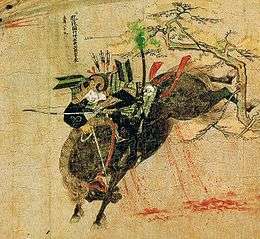Takezaki Suenaga

Takezaki Suenaga (竹崎 季長, 1246 – 1314) was a retainer of the Higo Province, Japan who fought in both the Battle of Bun'ei and the Battle of Kōan during the Mongol invasions of Japan. Suenaga commissioned the Mōko Shūrai Ekotoba, a pictorial scroll showing his own valor in war, composed in 1293. During the Mongol invasion of 1274, Suenaga fought at Hakata under Muto Kagesuke. Suenaga sold his horses and saddles in order to finance a trip to Kamakura in order to report his deeds in battle to the bakufu. In order to receive rewards for valorous deeds from the bakufu, it was necessary for the deeds to be witnessed by others and reported to the bakufu directly. By his own account in the scrolls, Suenaga says, “Other than advancing and having my deeds known, I have nothing else to live for,” showing that, first, he wanted to advance in terms of measurable money and rank, and that, just as importantly, he sought fame and recognition.[1]
Suenaga goes to great lengths to achieve what he views as the honor of the warrior. Although he is under orders from Kagesuke, the commander, to pull back at the very beginning, Suenaga disobeys. Asserting his own identity, he says, “Waiting for the general will cause us to be late to battle. Of all the warriors of the clan, I, Suenaga will be the first to fight from Higo.”[1] Rushing forward on his own, Suenaga encounters Kagesuke himself. Again Suenaga disobeys orders, this time from Kagesuke’s retainer. When he is ordered to dismount from his horse, he refuses, citing his desire to be the first into battle.
References
- 1 2 Conlan, Thomas D., trans. In Little Need of Divine Intervention. Ithaca, NY: Cornell East Asia Program, 2001.
- Takezaki Suenaga Samurai-archives.com
- Genko Borui
External links
- Mongol Invasion Scrolls Online interactive viewer for Moko Shurai Ekotoba from Bowdoin College.
See also
|